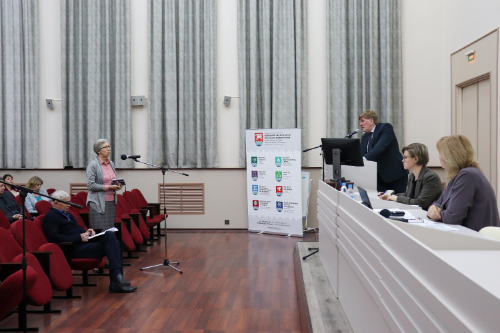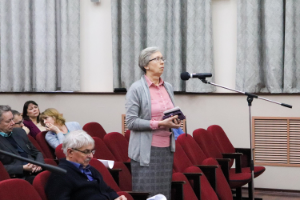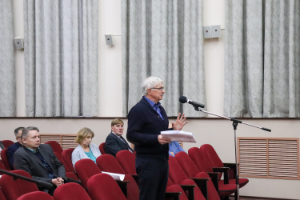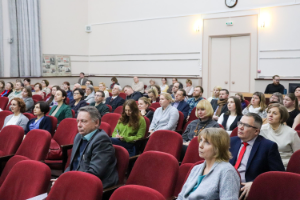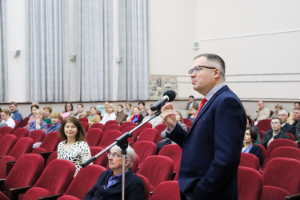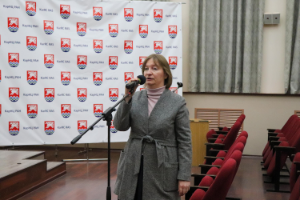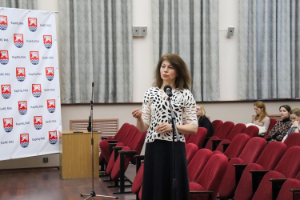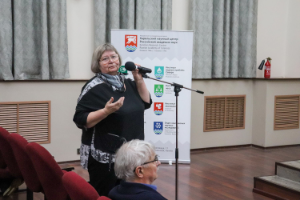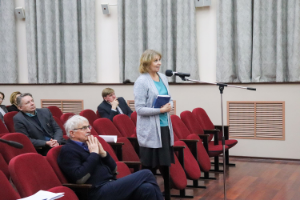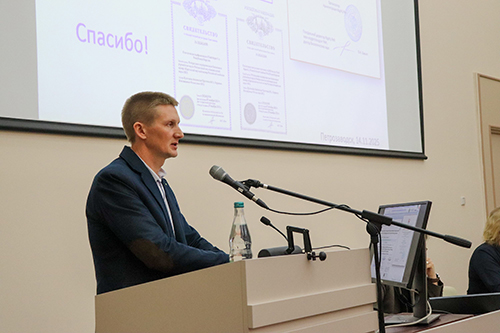The first reporter at the Jan 28th session was Director of the Institute of Biology KarRC RAS, Doctor of Biology Nikolai Ilmast. In 2024, biologists conducted research within 54 research and development (R&D) themes, including 8 state-ordered themes and 18 projects supported by the Russian Science Foundation (RSF).
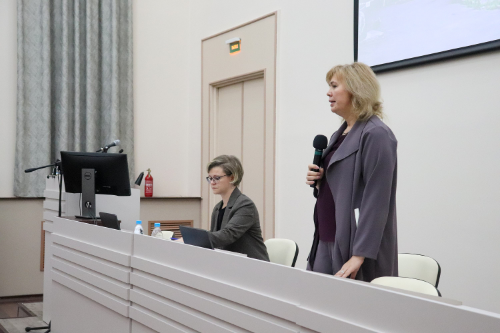
The session was opened by KarRC RAS Director General Olga Bakhmet
In particular, staff of the Laboratory of Ecological Biochemistry explored the eco-biological adaptation patterns during pink salmon migrations. The results are important for studying the species' characteristics and for monitoring this biological resource in Northwest Russia. The mechanisms for ecological and biochemical adaptation of lipid synthesis in sea bass in the North Atlantic were investigated. Biochemists also assessed the nutritional value of Antarctic krill for humans.
The Zoology Laboratory continues studying the biology and monitoring the population of the wild forest reindeer. Satellite data were analyzed and seasonal patterns of space use were identified. Staff of the Laboratory of Plant Ecological Physiology demonstrated that exposure to constant (24h) artificial light induces photooxidative stress in the plants, as opposed to the natural light regime. In this context, differences in the response of introduced vs. native species were highlighted.
Researchers at the Mire Ecosystems Laboratory proved there is a hidden threshold in the growth response of Sphagnum mosses to temperature. The difference in the temperature thresholds may be a previously unknown factor for species distributions. Working within the VIP GZ, laboratory staff calculated the pools and primary accumulation of carbon for four types of natural and two types of drained mire sites. These data can be used to correctly assess the role of wetlands in the global greenhouse gas flux.
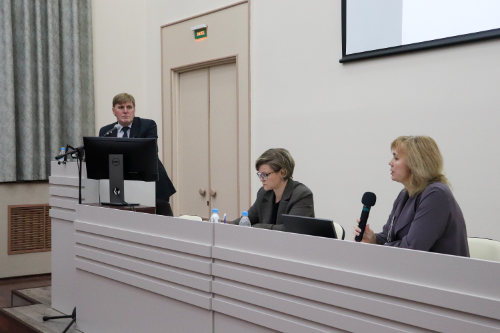
Director of the institute Nikolai Ilmast answering questions after his report
Karelian geneticists together with colleagues from Tyumen exposed the genetic relationship between the body mass index of people living at high latitudes and their long exposure to blue light at night. The laboratory has also done research important for the study of nonalcoholic fatty liver disease and colorectal cancer.
In the reporting year, biologists published a total of 266 academic papers, including 151 articles, two monographs and one textbook. They also prepared an essay for the Red Data Book of the Russian Federation and four essays for the State Report on the Environment in the Republic of Karelia. 31 databases were formally registered.
The results of the work of the Forest Research Institute KarRC RAS were reported by Doctor of Biology Alexander Kryshen. Studies were conducted within three state-ordered research themes, under five RSF grants and 17 agreements with Russian partners. Research within the VIP GZ project “Development of a system for carbon budget monitoring in forests of Eastern Fennoscandia” was continued.
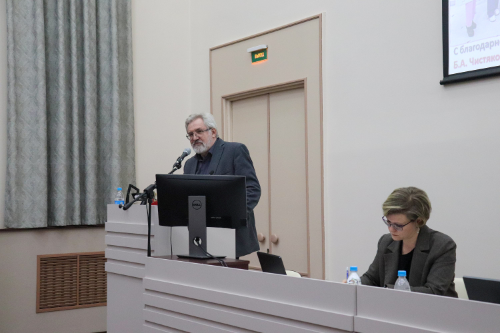
Speaking is Alexander Kryshen, Director of the KarRC RAS Forest Research Institute
Specifically, carbon distribution in sapwood and heartwood depending on the site conditions was studied for the first time for the case of 70-80-year-old Scots pine trees. It is proved that carbon content in wood in north-boreal pine forests may be underestimated by up to 10.8%. The key parameters that determine the conductivity of pine phloem at different ages in different climatic conditions were revealed. This is important for understanding tree adaptations to climate change.
– There is a debate going on about the importance of preserving old-growth forests. Their timber increment is low, and less carbon is sequestered. We hear opinions that old-growth forests should be cut down because young stands are better at dealing with the carbon deposition issue. In reality, this is not true. Old trees sequester carbon dioxide, but instead of storing it in their wood, they transfer it to the soil biota and it is deposited in the soil. Our research results show that old-growth forests must be preserved, - stressed Alexander Kryshen.
Scientists have also explored the role of downed deadwood in the natural regeneration of Norway spruce in primary mid-boreal spruce forests. The results can be used for scientific substantiation of spruce forest restoration methods. Patterns in the variation of forest-floor properties were revealed and its carbon stocks in mid-boreal forests were estimated. This is necessary to improve the accuracy of modeling the carbon cycle in forest ecosystems.
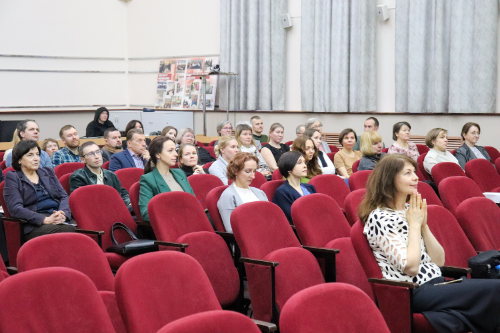
Participants of the meeting
Genetic studies of curly birch continue. Their results are important both for understanding the nature of the curly birch and for designing a technique for growing trees with desired properties.
Scientists have also supplemented the world database with facts on the species composition and abundance of small arthropods – springtails, in mid-boreal pine forests of Karelia. An article on this topic by an international team of authors was published in the Scientific Data journal of the Nature group.
In total, the Institute's staff published 70 academic articles. The research results were used in the preparation of the State Report on the Environment of the Republic of Karelia. Five databases were registered.
An account of the work of the Northern Water Problems Institute (NWPI) KarRC RAS was given by Doctor of Biology Yulia Lukina. In 2024, the Institute implemented studies within six state-ordered research themes, under two RSF projects and nine commercial contracts.
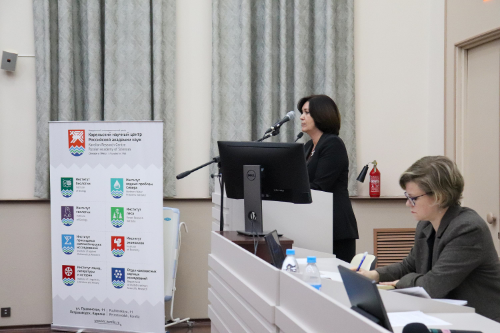
Report given by NWPI KarRC RAS Director Yulia Lukina
Scientists at the Institute continue studying the climatic variability and the ice regime of lakes. The warming and the precipitation regime alter the conditions of ice formation on small lakes: the thickness of the hard crystalline ice decreases and the share of the looser white ice increases. It may sometimes be up to 95% of the total ice thickness. This is critical from the safety point of view: it is scientifically proven that the load-bearing capacity of ice decreases, which should be kept in mind when going out on lakes in winter. In terms of theoretical significance, it is noteworthy that an increase in the share of white ice is a factor that mitigates the impact of warming on the ecosystem of lakes, as it is less permeable to sunlight.
The work on the long-term forecast of changes in the ecosystems of lakes Onego and Vygozero is underway. Scientists have verified the biogeochemical model of Lake Onego and estimated that by 2050 the increase in water temperature and nutrient load will lead to a 30% growth in the volume of organic matter primary production in its bays.
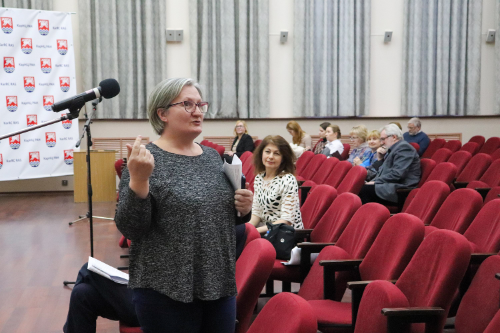
Head of Hydrophysics Laboratory at NWPI KarRC RAS Galina Zdorovennova studies ice on small lakes
Integrated studies are conducted on the White Sea and its drainage basin for promoting the development of the Russian Arctic Zone. According to one of the probable scenarios, the average air temperature in the western part of the Russian Arctic will increase by 2-3 degrees by 2053. The search for areas of the White and Barents Seas suitable for mariculture is underway. The Pomor coast of the Onega Bay of the White Sea has been identified as the most promising in this respect.
A new topic for NWPI is research on the state of the White Sea coastal ecosystem within the Solovetsky Archipelago. Last year, a network of sampling stations was established, characteristics of the bay's hydrodynamic regime were determined, the plankton community was described, and the trophic status (highly eutrophic) and water quality (highly impure) were assessed. The anthropogenic load has increased over the last 30 years.
In 2024, scientists of NWPI joined the work done by RITM Carbon Consortium. Karelia has become one of the first regions in our country, where unified methodological approaches to estimating greenhouse gas storage in and emissions from water bodies are being worked out. In the future, this experience can be extended to aquatic ecosystems in other regions of Russia.
The results of the Institute's research work are summarized in 117 scientific publications. Two databases have been registered. New samples get added to the collection “North Russian Lake Sediment Cores”. Speaking of international cooperation, contacts with colleagues from China are developing and proposals for joint project applications have been prepared.
Doctor of Geology and Mineralogy Sergey Svetov reported on the results of work of the Institute of Geology KarRC RAS. In the reporting year, the Institute carried out research on five state-ordered research themes, as well as under seven international programs and projects, and five RSF projects.
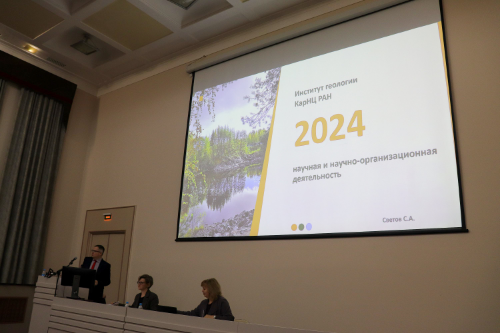
Director of IG KarRC RAS Sergey Svetov presents the results of the institute’s work in 2024
The Laboratory of Precambrian Geology and Geodynamics continues its research in the Kostomuksha iron-ore district within an RSF project. In particular, scientists discovered new Neoarchean conglomerates aged 2.71 billion years. They have features similar to the Timiskaming gold association of the Canadian Shield. Previously, scientist working within this project determined that the most ancient iron ores formed in the area around 2.83 billion years ago in rift valleys within an underwater oceanic volcanic plateau.
Geologists have also studied agate formations associated with Karelia’s unique sedimentary rocks – shungites, formed some 2 Ga BP. Specialists have studied the genesis of these agates, described their structure in detail and proposed models that are important for understanding ore formation processes in the region.
A system for analyzing the degree of the mining impact on the environment was developed and tested within interdisciplinary studies using remote sensing methods. Examination of the satellite images has enabled the scientists to track changes in the landscape, including forests and water bodies, in the territory of the Kostomuksha iron ore deposit.
In total, the Institute’s staff published 58 articles in scientific journals last year.
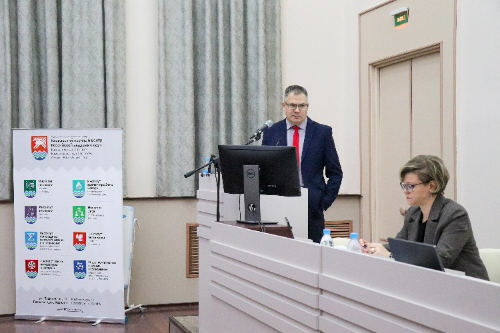
Sergey Svetov answers questions from the audience
Scientists do a lot to popularize the geological science. E.g., the exhibition “7 Rocks of Karelia Everyone Should Know” was organized at the Republic of Karelia National Library. The exhibition has now moved on to schools of the republic. Despite the ongoing renovation, excursions were held in the Museum of Precambrian Geology. The museum continues to host the Archean Young Geologists Club for schoolchildren. Enrollment in new groups is currently underway.
The second part of the KarRC RAS Learned Council meeting will take place on January 29. The main results of scientific and research-administration activities during 2024 will be presented by leaders of the Institute of Applied Mathematical Research, Institute of Economics, Institute of Linguistics, Literature and History, and the Department for Multidisciplinary Research KarRC RAS.




